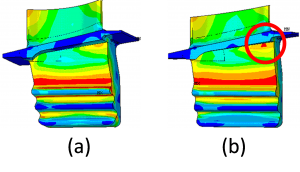Mentor: Felipe A. C. Viana
Description: Servicing of machines for transportation, power generation, and oil and gas industries presents innumerous opportunities for multidisciplinary optimization and uncertainty quantification. Engineers and analysts are constantly challenged to balance performance, reliability, and cost, while industry is addressing growing demands, tight regulations, and the need for rational use of resources. In that context, condition-based maintenance (CBM) strategies have greatly evolved over the years. Today, the most successfully adopted approaches leverage sophisticated models that are able to combine physical understanding of machine behavior, sensor data that capture machine operation, and field inspection data. While using high-fidelity engineering models (e.g. non-linear finite element models) is desirable; in reality, it might not always be possible. Factors like computational cost, limited understanding of boundary conditions, partially or totally unknown failure mechanisms can limit the physical fidelity of the models. The disastrous result are models that cannot account for variations in operation, material, and manufacturing; and that is exactly why uncertainty quantification is so important in CBM. The Bayesian framework has been successfully used to quantify uncertainty due to (a) model parameters, (b) number of simulations and experiments, and (c) discrepancy between the simulation code and the actual physical system. To illustrate the importance of this aspect, the figure shows the stress distribution over a turbine blade surface under nominal condition and with a small decrease in cooling flow (every other boundary condition kept practically the same). In the field, such variation would be explained by disturbances in cooling circuit (due to manufacturing or simply clogging). Unfortunately, it would be extremely hard to catch it until the machines with stress characterized by the figure start to present cracking at the highlighted hot spot. This research will focus on Bayesian calibration of reduced-order lifing models with applications to machine services and fleet reliability management. The main body of the work will consist of building lifing models, defining and designing calibration given the nature of field inspection data, quantifying uncertainties and performing sensitivity analysis, as well as using the Bayesian framework for fleet management.
The research will involve the collaboration of one graduate student and one undergraduate student. Viana will advise and guide both to ensure they are exposed to theoretical and computational aspects of Bayesian uncertainty quantification and decision making; each one will tackle tasks commensurate with their skill set. The REU student will be responsible for deriving and implementing computational code for a library of reduced-order models of different failure mechanisms (e.g., crack initiation and propagation under low cycle fatigue, micro pitting, creep, etc.). The REU student will be directly involved in verifying and validating the code against different applications. The graduate student will be responsible for implementing the Bayesian framework and scaling up simulations to enable study of a large fleet of assets (e.g., aircrafts owned by an airline or several trucks of large mining company). Both students will collaborate on tasks such as sensitivity analysis to understand the impact of variation in material, manufacturing and operation. These tasks and collaboration with the graduate student will expose the REU student to applied research and serve as the basis for graduate-level theoretical and computational work. The successful completion of this module will culminate in documenting the research findings through poster presentation and publication in top conferences and journals.

Stress distribution turbine blade under nominal conditions (left), slightly decreased cooling flow (right)